This first table shows the XE’s Watts/10 Delta Temp numbers in a quick glance chart format.
Using the data compiled from the XE thermal testing I have compiled the following tables in an attempt to show other ways of how its performance varies against itself at the flow rates and fan speeds tested. Effectively these show percentage gains relative to a reference point. It’s an interesting way to show gains/losses while changing a variable.
First let’s focus on 1300 RPM as our reference and see how much gain or loss in performance we get by changing fan speed.
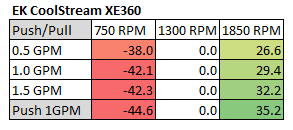 The high percentage changes from 1300 rpm to 750 rpm indicates the XE had a significant boost in performance with this fan speed range. In the next plot we focus on changing the flow rate with 1.0 GPM as the base line.
The high percentage changes from 1300 rpm to 750 rpm indicates the XE had a significant boost in performance with this fan speed range. In the next plot we focus on changing the flow rate with 1.0 GPM as the base line.
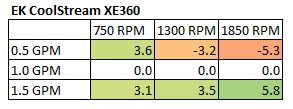
With only slight percentage changes when changing the flow rate this could mean a couple of things. The flow rate is not a determining factor for performance on the XE or that the core is extremely well tuned for a low flow rate and little performance gains are made with increasing flow rates. I tend to favor the later as being the most likely explanation.
Normally here the 0.5gpm 750rpm table is shown, but due to the odd result at that data point lets look at the XE in reverse fashion by by using the 1.5 gpm and 1850 rpm as our reference points:
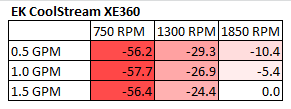
This shows us performance percentage losses as either or both of the two references are changed. Clearly the airflow change is the dominant factor at play.
Lastly, we change the reference and choose our center 1300 RPM and 1.0 GPM as our reference point to show both effects concurrently:
So from the data above we can get a very good idea of how the XE 360 radiator performs relative to itself. But there is a large selection of 360mm radiator models to choose from, released from numerous manufacturers. So, we need to start comparing performance between them. To see how the XE performed against the other radiators tested, I have included the averaged flow rate comparison charts from the Round Up. We’ve seen that the flow rate has little impact on thermal performance so averaging of the 3 flow rate results gives us a good look at head to head performance at the rpm speeds tested at with even less error.
Push Only Data vs Competition
Let’s focus on the Push Only results for now and come back to the Push/Pull data later. While for Push/Pull we tested three flow rates, the Push Only testing was conducted only at 1GPM in order to save time.
Let’s start with 750 RPM and see how it compares to the competition:
The XE places in the middle of the pack in the low speed Push Only rankings. Not a surprising result given it’s medium/high FPI and thick core.
How does the XE do at 1300 rpm?
Pretty darn well actually:
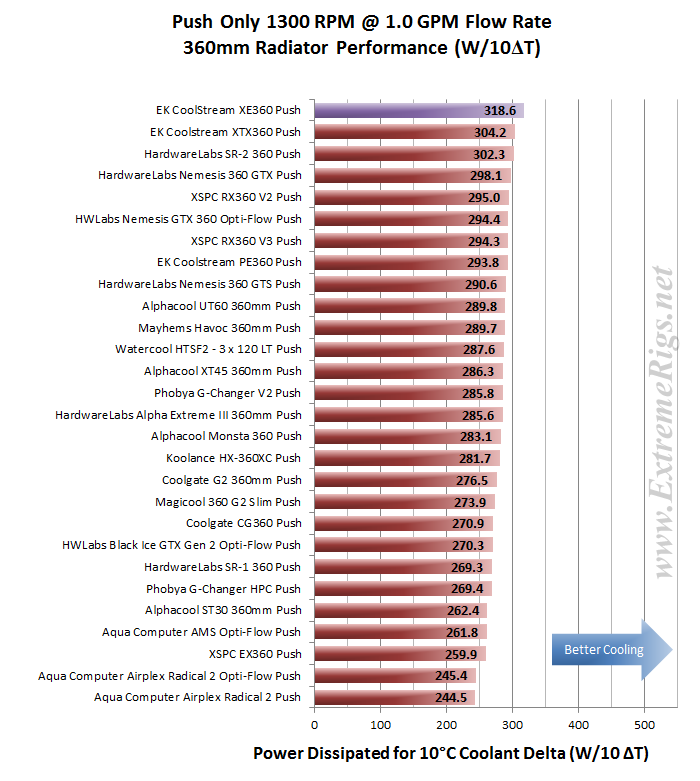
Jumping up and into first place first by a clear margin, ~4.5% ahead of the nearest rival (ironically EK’s own XTX which the XE replaces). I think we’ll find the XE really starting to hit it’s strides as the air flow is increased:
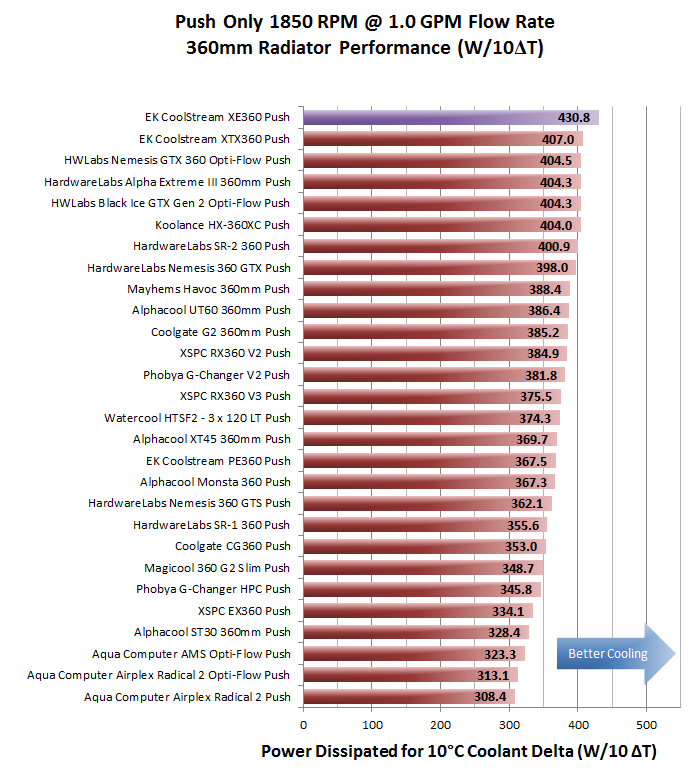
At 1850 Push Only the XE again takes first place, now 5.5% clear of the now superseded XTX. At the time of writing the XTX has become EOL, even prior to the XE being released.
So the XE was average at low fan speeds in Push Only (as expected given the medium PFI count), but WOW did it perform with medium and high speed fans. One could reasonably expect this dominance to continue when we add more fans and test with a Push/Pull assembly.
Let’s find out…
Push/Pull Data vs. Competition
Let’s now look at the Push/Pull results and see how the XE 360 compares. For Push/Pull we have averaged the results from the 3 flow rates at which we tested.
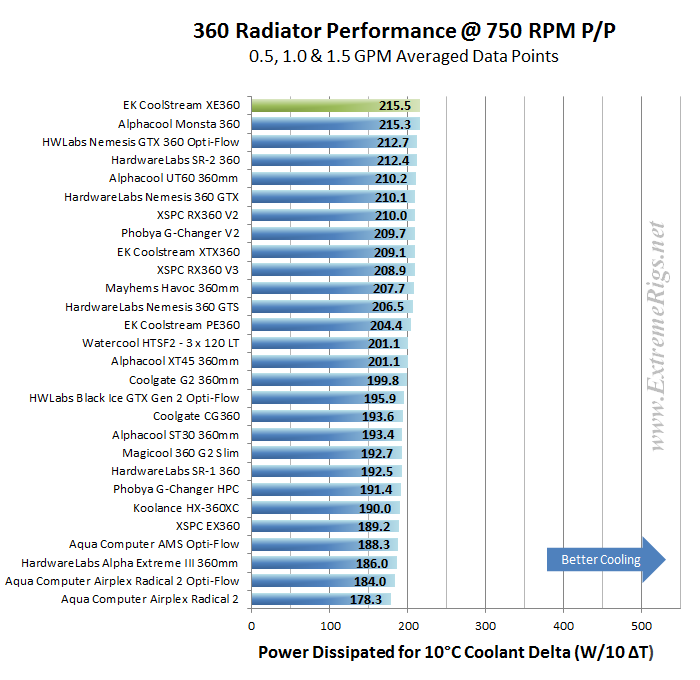 The XE 360 continues it’s winning streak taking another first place. Of the three individual flow rates making up the averaged result, the XE placed first in only the 750 rpm category, but was top 5 and close enough in the other to give it the winning overall average.
The XE 360 continues it’s winning streak taking another first place. Of the three individual flow rates making up the averaged result, the XE placed first in only the 750 rpm category, but was top 5 and close enough in the other to give it the winning overall average.
Let’s move to the 1300 rpm then:
In the 1300 rpm category the XE was again the top performer. It dominated the medium fan speed category taking first place in each of the 3 flow rate tests.
The averaged 1850 rpm results:
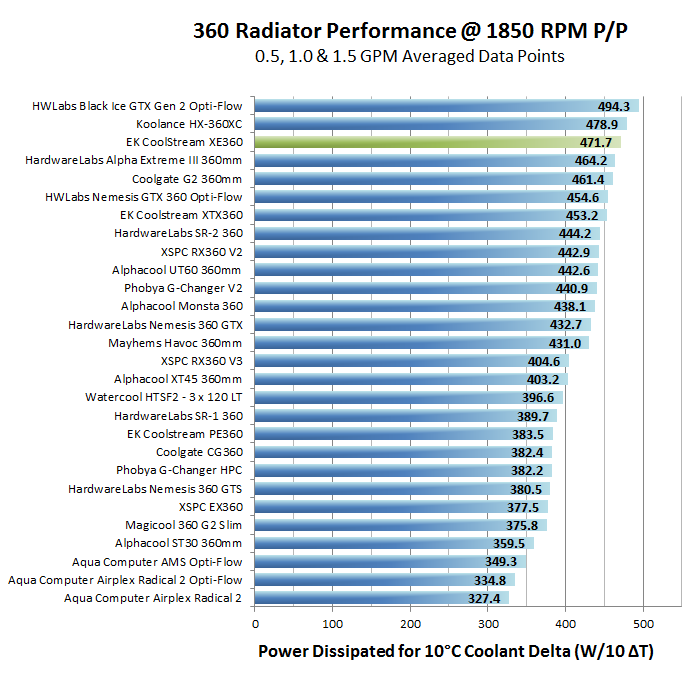
At 1850 Push/Pull the XE360 dropped to 3rd place, ~4.5% behind the category winner. Both the rads above it are dense FPI rads and tuned specifically for high speed fans. The XE has done exceptionally well to beat all other comers
So the XE gets 4 out of 6 category wins plus a 3rd place. This is pretty amazing that EK have come up with a core that performs so well in nearly every scenario. Finally we have a radiator that is well tuned for almost all usage scenarios.
Let’s now combine both the push data and the push/pull data – this can help to clarify which option may be more beneficial if looking to upgrade performance for a Push Only installation – to spend money on extra fans or a different radiator.
Again the 750 rpm first:
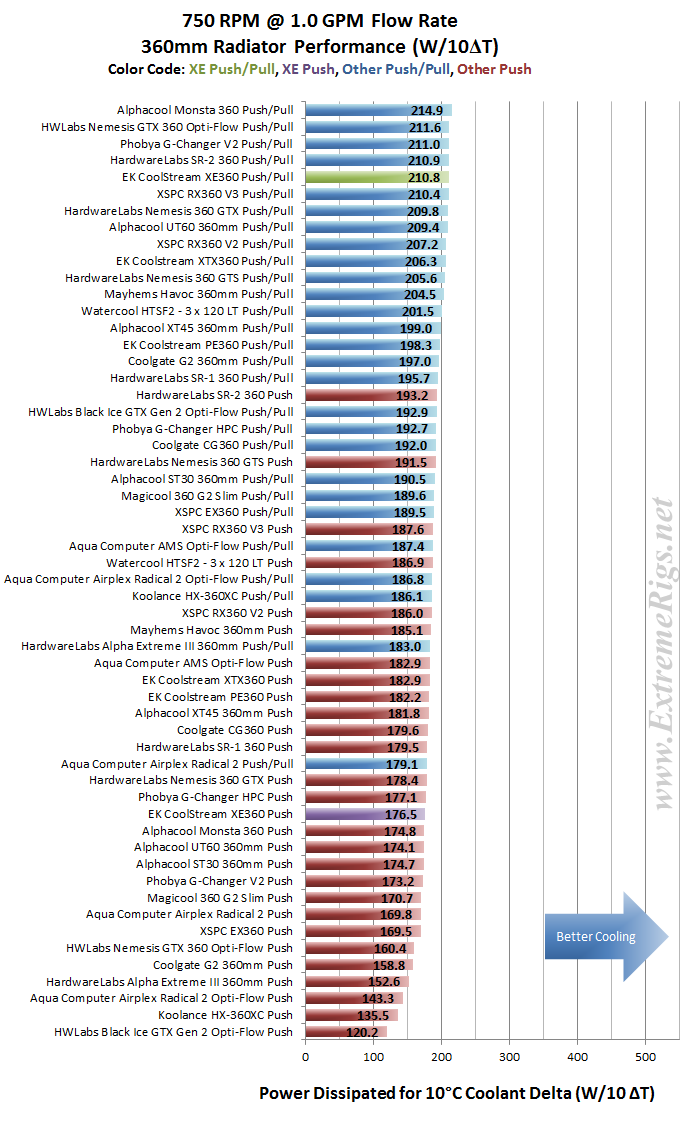
The 750 rpm tests were the XE360s weakest results in comparison to the others. Again this can be attributed to the medium FPI core. It still does very well in Push/Pull and while the Push only result looks to be well behind the leader, it is only ~9% behind the Push Only winner.
At 1300 rpm:
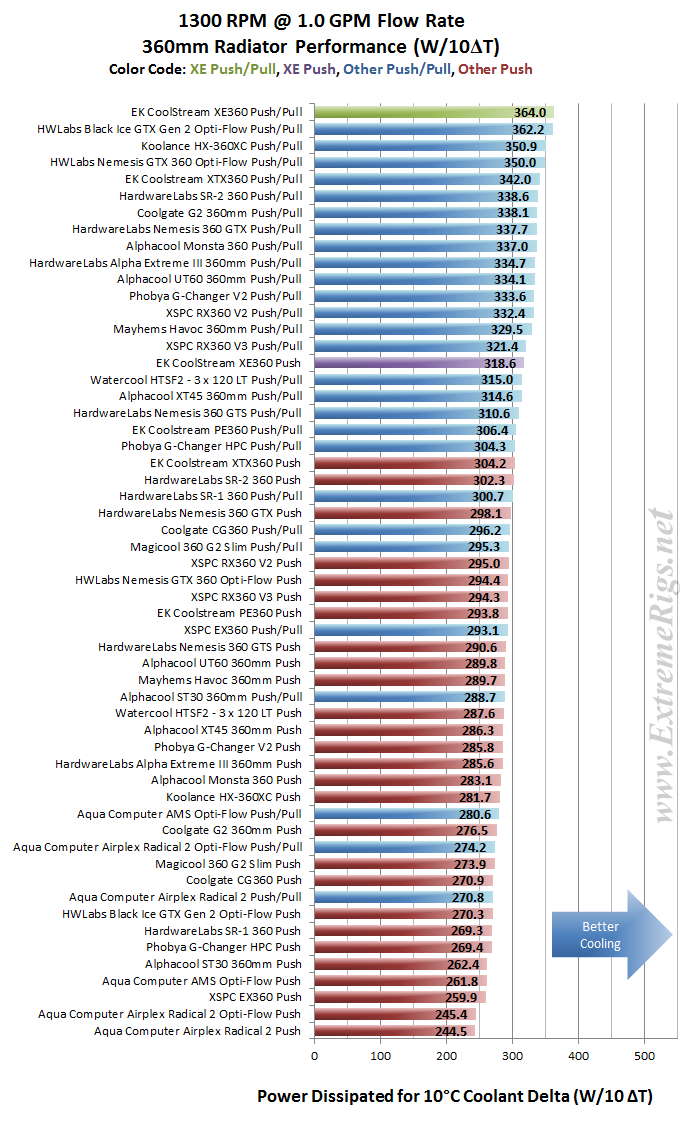 The EK XE 360 donimates in both Push Only and Push/Pull. Notice how many Push/Pull results that the XE’s Push Only has beaten, over half of them – unbelievable!
The EK XE 360 donimates in both Push Only and Push/Pull. Notice how many Push/Pull results that the XE’s Push Only has beaten, over half of them – unbelievable!
At 1850RPM the trend continues with 1st place in Push Only and 3rd at Push/Pull:
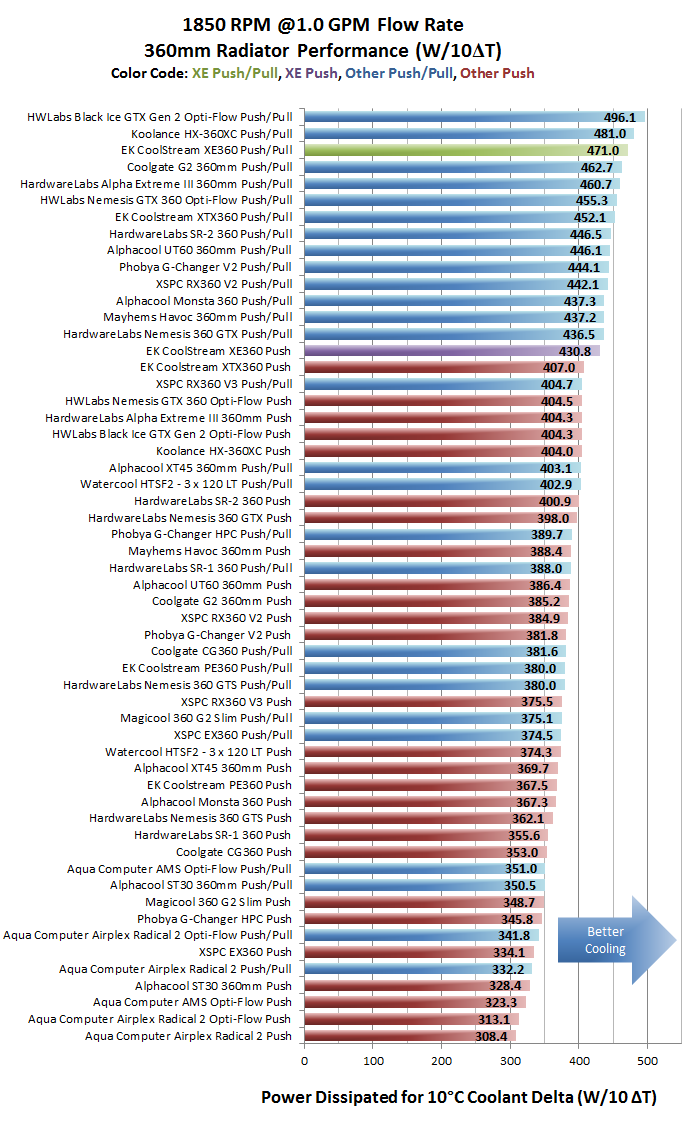
From all of test results we created “Average Performance Factor” charts for both Push and Push/Pull and then a combined plot called the “Master Performance Factor”. The radiator with the best cooling ability (W/10ΔT) at each gpm/rpm combo was awarded a score of 100, and each other radiators W/10ΔT result was scored as percentage of the top performer.
This way of looking at the comparison takes away any advantages that a radiator may have at higher or lower fan speeds and looks at an overall average. While this appears fair it does tend to favor those radiators that are all-rounders and those radiators which do very well at high RPM. Most users should be more focused on their specific use case. Check in the Round Up for performance comparisons at every gpm/rpm combo for even more details and cross comparison results.
Here is the XE 360’s Push/Pull percentage scores at each data point that thermal tests were conducted at and additionally the 1.0 gpm Push Only percentages relative to the winner at each fan speed.
An impressive result table to say the least, with 6 out of 12 category first places, 5 out of 6 less than 5% behind the winner and the other less than 10 %. The XE 360 has proven to be a dominant all-round performer. Stating the obvious, it is by far the best set of results of the test group.
Then we started averaging the percentage scores to give us the Averaged Performance Factors of each radiator.
Firstly – the Push Only APF:
The XE gets 1st place edging out the SR2 which is seemingly better tuned for low speed fans and had swept the floor with it’s results when we tested it. The XE has blown me and most of the competition away.
The XE360 also gets 1st place in the Push/Pull also. With a score of 98.1 is the first time that any rad will be awarded a 5/5 for Push/Pull performance using our scoring system.
Finally we created the Master Performance Factor which is calculated from the averaged results of all the thermal tests, Push and Push/Pull at all flow rates and all fan speeds:
In the Master Performance Factor comparisons the XE 360 finishes in first place! The XE 360 relentlessly pumps out high results across all the test data points and so the XE will become our latest “Best of the Bunch” award winner when we revise the performance awards after testing is complete.
I really didn’t expect the XE to perform so well across the board, particularly at the lower fan speeds, but it did. The XE’s core does appear tuned best for medium to high fan speeds, but it is extremely versatile, also outperforming virtually every other rad of the test group in the low fan speeds tests. In two words then – outstanding performance!
Next up – Summary!








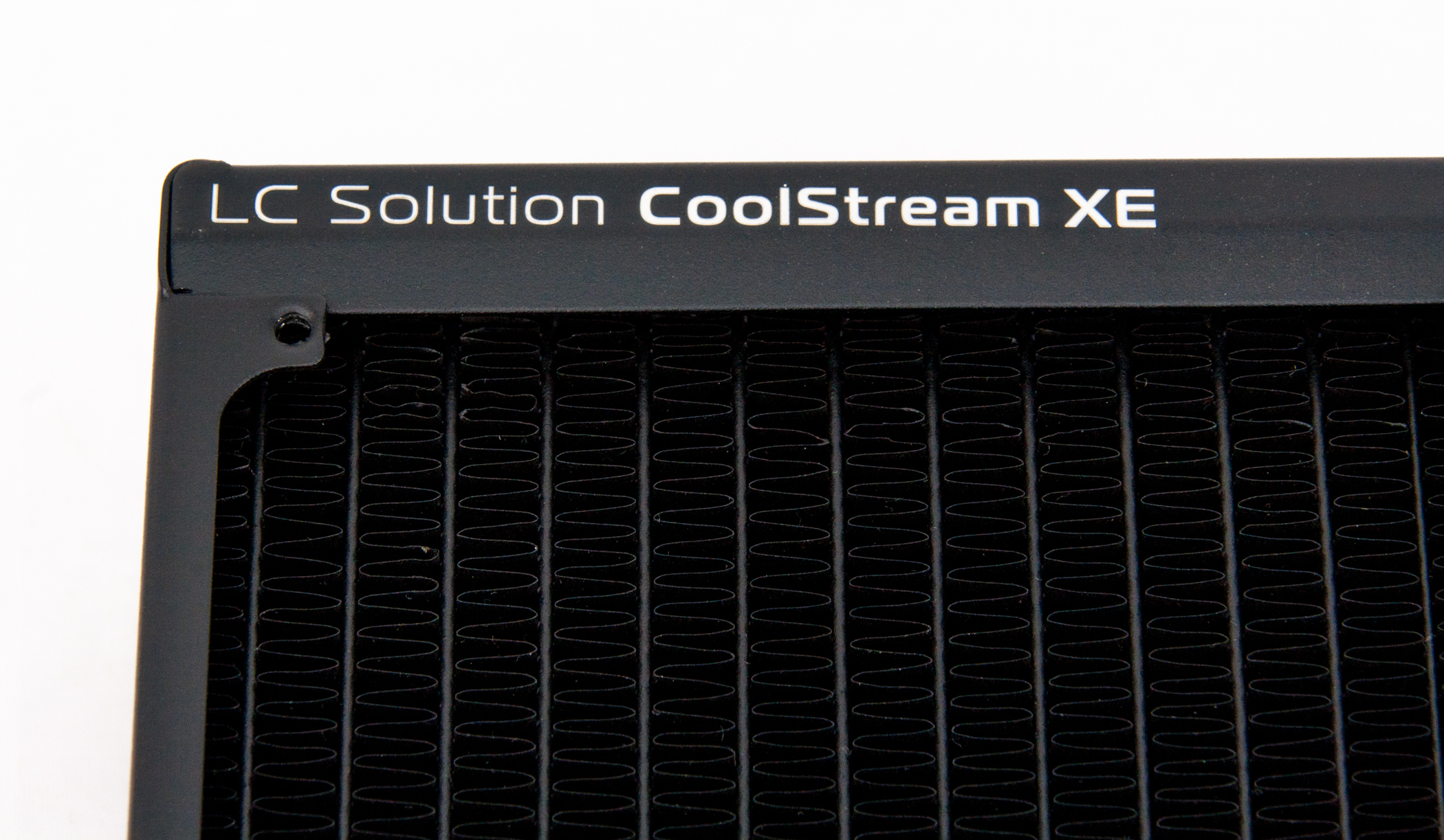

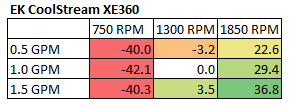
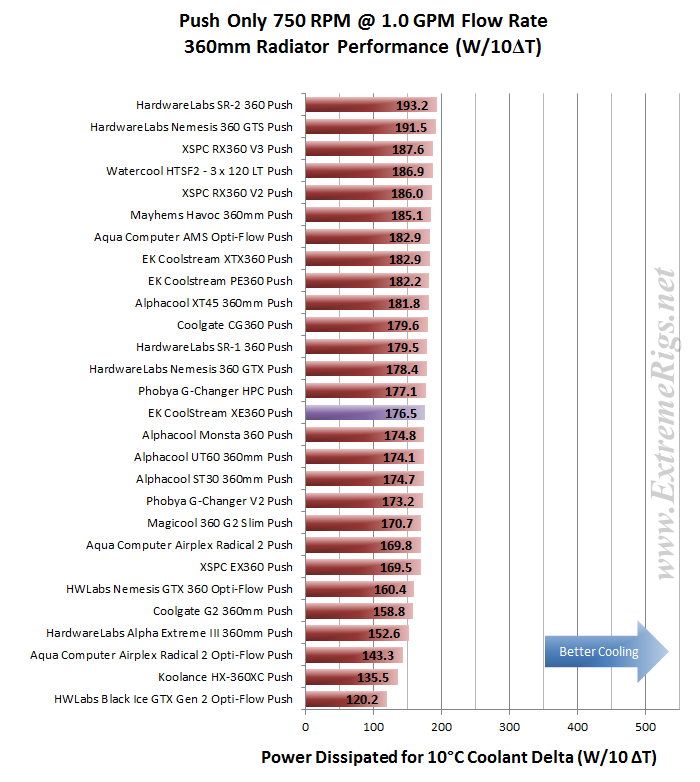
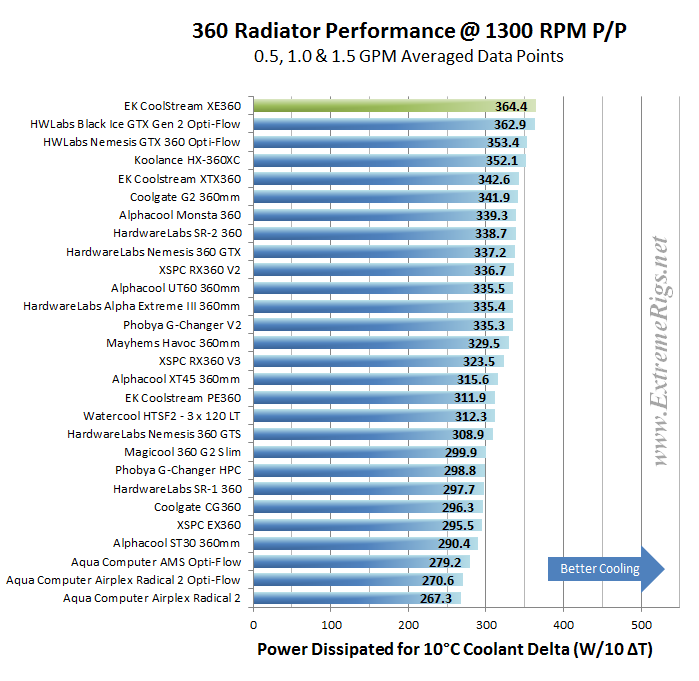
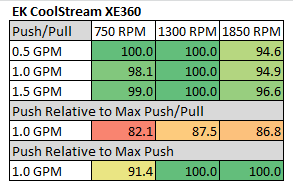
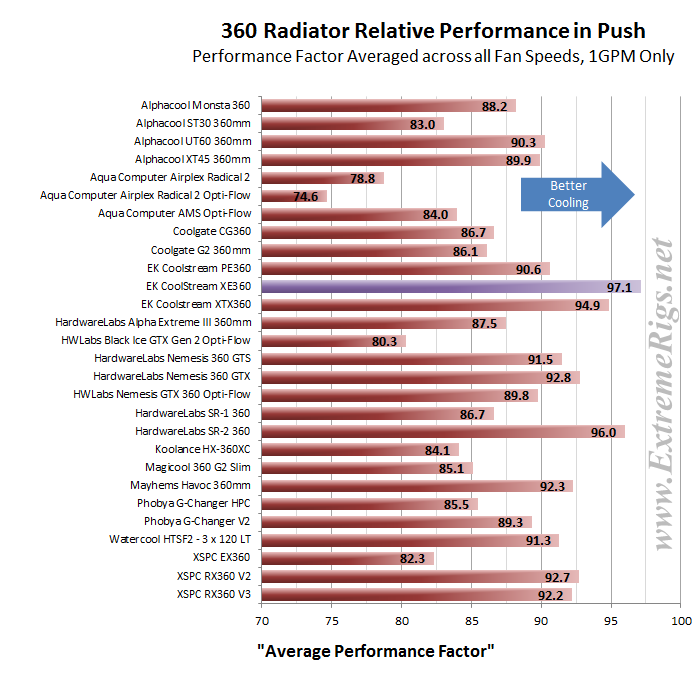
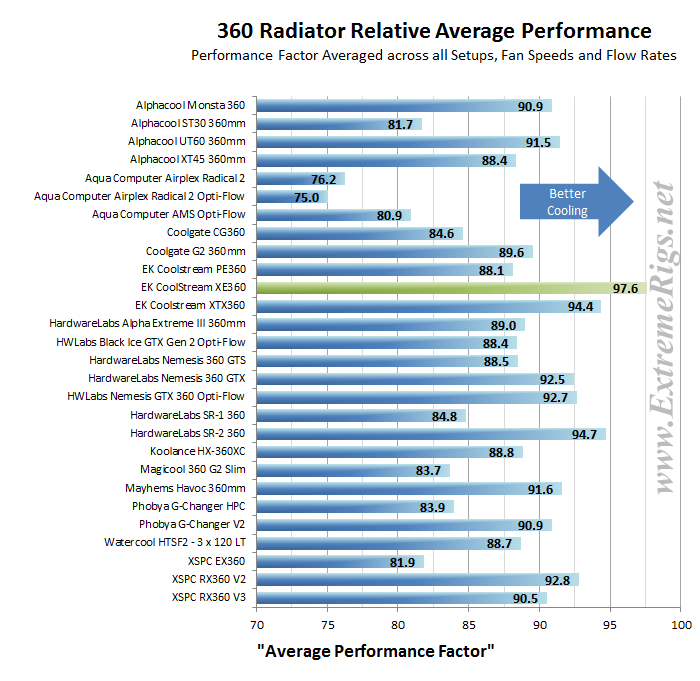
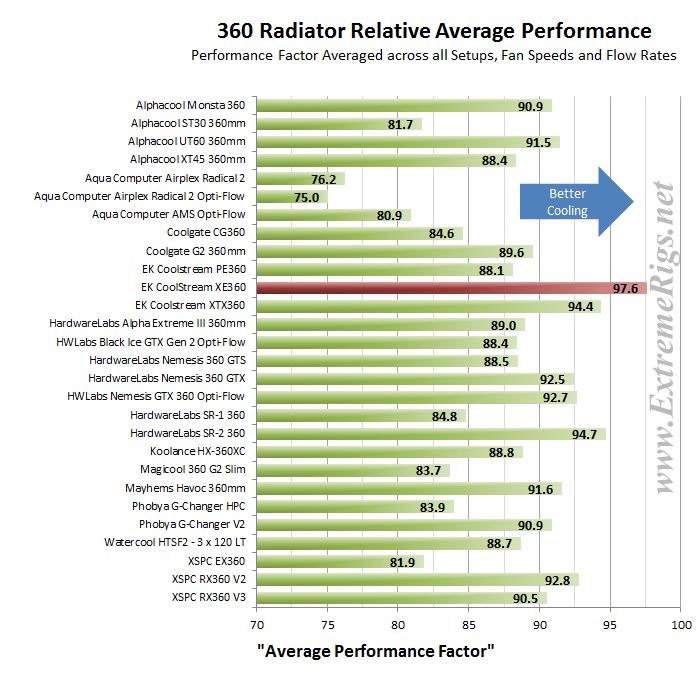



Another great review of a great rad. Excellent work Fast Fate and EK.
Will have a couple of these on their way as soon as I can.
On your analysis page when comparing the average GPM @ 750/1300/1850 P/P your graph for this review differs from say the coolgate G2 review analysis numbers. Power dissipated on the G2 review page at AVE GPM 1850 P/P is 497.7 and in this review it shows the G2 @ 461. This discrepancy is across all radiators and fan speeds in your group A reviews, the power dissipated is much lower in this review.
I know you changed your temp reading set-up to get better accuracy but I never found anything referencing the change in Power dissipated due to that. Its confusing, could you please explain why the numbers changed.
BTY, always great reviews…..thank you!!
Good catch! Yes this is because for Group A we were using averaged power dissipation numbers across all of Group A. After publishing Group A and continuing analyzing numbers with Group B we found that repeatability was increased by using calculated power dissipation from each run rather than the average over all tests. Therefore all later numbers are processed using this method. Soon we will be going back and editing all the results to be consistent in the methodology
[…] EK CoolStream XE 360mm Radiator Review […]
[…] with the screws provided with the XE (which we reviewed last month) the short screws measured in at 6.5mm, just slightly longer than the 5mm as listed by […]
Thanks for the review.
This seems like close to the “ultimate” radiator it would seem.
Basically, this thing needs 2 things as you’ve noted:
– Screw protectors (this I think is a big oversight and would not be hard to integrate at all)
– A fill/bleed at the end (this I think is less important)
Otherwise, this is basically the ultimate radiator. I suspect that an 85mm version thick “Monster” variant of this would be able to outperform even the HWLabs GTX Black Ice.
Do you think that the louvered fins and higher tube count (14) are responsible for this radiator’s all around good performance?
Not sure if my commented posted earlier, but this is a repost.
It would seem that the ultimate radiator then would be a thicker variant of the XE 360mm. It’s interesting to note that this fan, despite it’s medium fin density, keeps up with all other radiators across the board.
Why?
– Perhaps the louvered single fin design is superior?
– I also note that it has 14 tubes, rather than the typical 12 tubes.
I’d be interested to hear your thoughts on that.
I would guess that a “Monster” radiator thickness (say 85mm or perhaps even 100mm) would be probably the ultimate radiator, especially if they could fit more tubes in.
I hope that in the future, EK will add screw protectors. That I think is a big oversight.
Anyways, thanks for the review.
[…] So EK have confirmed that dents will not turn into leaks – so if you have dents then feel free to carry on with your life. I am confused about the statement that only the 480 radiator is affected given that we’ve seen dents on other sizes. Still there is an option to RMA if you’re at all concerned. Hopefully this is the last we see of the issue because the XE is a great performing radiator! […]
[…] reviewed the 360mm version for the Extreme Rigs Rad Round Up 2015, so if the 360mm size is more your flavor be sure to check […]
Comments are closed.